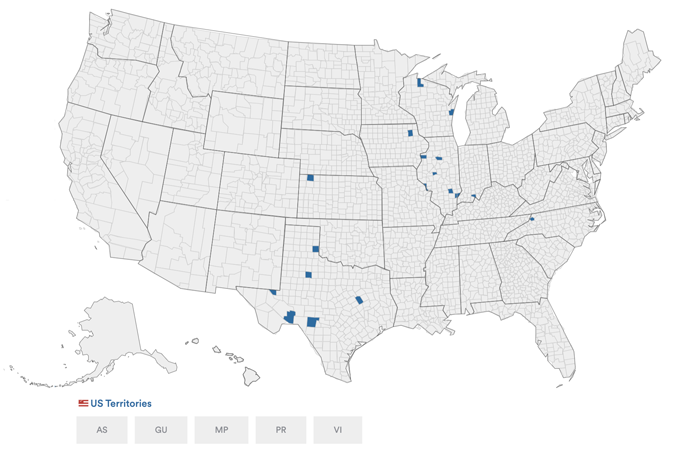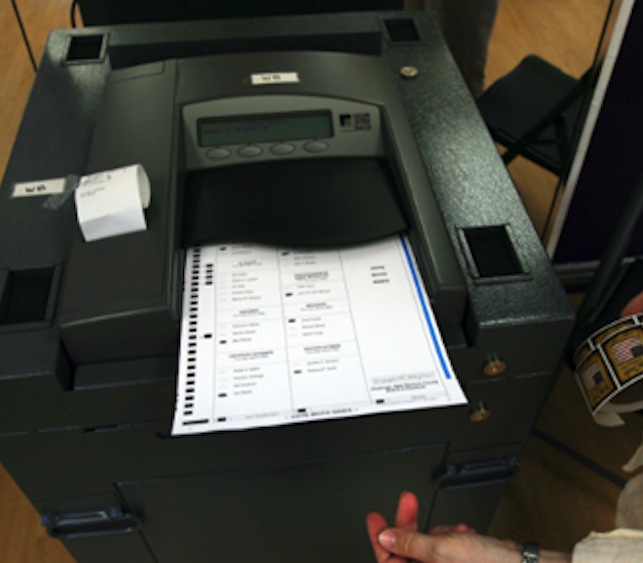
Election Systems & Software
Model 100
Make / Model: ES&S Model 100
Equipment Type: Hand-Fed Optical Scan Tabulator
Overview
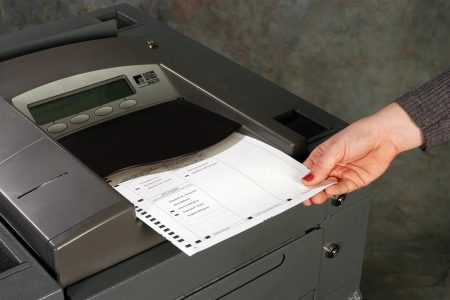
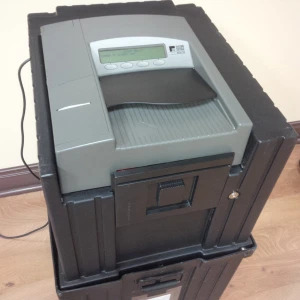
The ES&S Model 100 is a hand-fed optical scanner and tabulator that uses visible light scanning to count and record voter information from paper ballots. The Model 100 uses a mark-sense ballot, which may vary from one column to three columns across a ballot 8.5 inches in width, and from 14 to 21 inches in length. Each column of the ballot consists of one or more contests, each with one or more candidate or measure selection positions. The ballot may be printed on one or on both sides.
The ES&S Model 100 is most often used a precinct tabulator to scan hand marked paper ballots and ballots marked by an AutoMARK or ExpressVote ballot marking device. Many smaller and medium-sized jurisdictions also use the Model 100 to tabulate absentee mail ballots.
In the 1980s, the advent of simple one-dimensional sensors spawned a revolution in such applications as fax machines and page scanners. The first machine to incorporate this technology into a ballot tabulator was the American Information Systems PBC 100 scanner, later known as the Model 100. The system, which came on the market just as AIS was reorganized into ES&S, uses an Intel 80386 microprocessor to process the data from the image sensor. It reads the election configuration from a PCMCIA memory card before opening the polls. When the polls close, it records the results to the memory card and optionally transmits them by modem to the election office.
It is a portable device which measures approximately 14.25 inches wide, 16.25 inches deep, and 5 inches high. Its exterior is constructed of high-impact plastic. The unit weighs 19 pounds, 7 ounces with the battery included. The Model 100 is secured into its companion three-compartment ballot box. The ballot box comes in two variations – one metal and one plastic – that is collapsible and is equipped with wheels. In the operational mode, the ballot box is 35 inches high, 20.75 inches wide and 25.25 inches deep. In its nested or transportable mode, ballot box dimensions are 20 inches high, 21 inches wide and 25.5 inches deep.
Voting Process

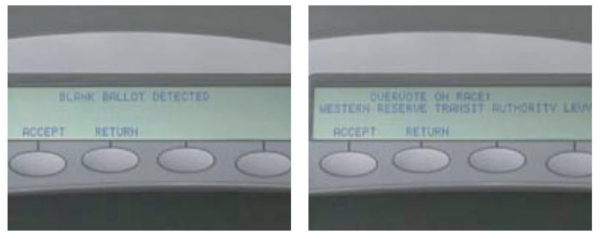
After checking in at the polling place the voter receiveds her ballot and proceeds to an available voting booth. Adjacent to each candidate or issue selection position is printed an unfilled oval. The voter uses a marker to fill in or darken the oval.
Several types of marking devices are suitable for use with the Model 100. A carbon ink-based felt-tip marking pen which produces a mark of adequate reflectivity is the preferred marking instrument in the polling place. The reflectivity specifications of such markers, as well as the manufacturers thereof, are available from ES&S. A Number 2 lead pencil can also be used.
After making her selections, the voter places a voted ballot into the ballot entry slot, which causes the drive motor to be energized, and the ballot is taken into the device for processing.
The front face of the Model 100 contains a four-line, 40-character per line LCD message display area. The voter should check this screen to see if any problems have been detected with the ballot such as overvoting or undervoting. The voter should press return to retrieve the ballot to correct any mistakes. To complete the voting process the voter presses Accept.
After the ballot has passed through the read station and the voting marks on it have been interpreted, it is placed into the ballot box or it is diverted to one of two compartments in the ballot box as determined by the jurisdiction using the device.
Videos
Demonstration of the Model 100 from Arkansas
Voting on an ES&S Model 100
References
Resources
Ohio Secretary of State EVEREST Review Summary Report (2007)
Ohio Secretary of State EVEREST Executive Summary Final Report (2007)
Ohio Secretary of State EVEREST Technical Manager Report (2007)
Ohio Secretary of State EVEREST Technical Details (2007)
Ohio Secretary of State EVEREST EVEREST: Evaluation and Validation of Election-Related Equipment, Standards and Testing (2007)
Ohio Secretary of State SysTest Labs Technical Report (2007)
EAC Formal Investigative Report on ES&S Unity 3.2.0.0 (2011)
Security Concerns
Security Seals
Ideally, the M100’s exposed ports, memory card access areas, ballot box doors and case seams would be covered with tamper-evident security seals. The integrity of these seals should be maintained at all times, and only breached under controlled, explained circumstances. Seals should be logged to maintain chain of custody of sensitive materials.
Ballot Box Access
Optical scan systems have at least one and possible more ballot boxes. Each ballot box should be inspected by a voter at the beginning of voting to make sure that they are empty. These ballot boxes should locked and/or be sealed with tamper-evident tape.
Memory Card is Sensitive
Corrupt memory cards may be able introduce viruses, cause the main election server to crash and falsify votes. Access to the memory card should be controlled, monitored and logged at all times.
Correct Inks
Some Optical Scan systems have trouble reading red inks or inks with red in them. Voters should use the writing instrument provided at the polling place or, if voting at home, black ballpoint pen that does not bleed through paper.
Keys
The keys for the M100 are the same for all M100 machines and are easily pickable with readily available tools. Care should be observed around the ballot box lock and the scanner key lock (turns the system off and on).
Counterfeit Ballots
It is fairly easy to frustrate the counterfeit ballot detection mechanism on the M100. People who produce counterfeit ballots could cast multiple votes and the detectability of these ballots would only depend on how close they appeared to be like the real ballot cards.
Manufacturer Profile
Election Systems & Software was founded in 1979 as American Information Systems Inc. (AIS), it merged with Business Records Corp. the following year and changed its name to ES&S. It is now a subsidiary of McCarthy Group, LLC, and McCarthy Capital. As of 2007 it was the largest manufacturer of voting machines in the United States, claiming customers in 1,700 localities. As of 2007 it had approximately 350 employees; 2005 revenues were $117 million. ES&S announced its purchase of AutoMARK Technical Systems on January 28, 2008.
